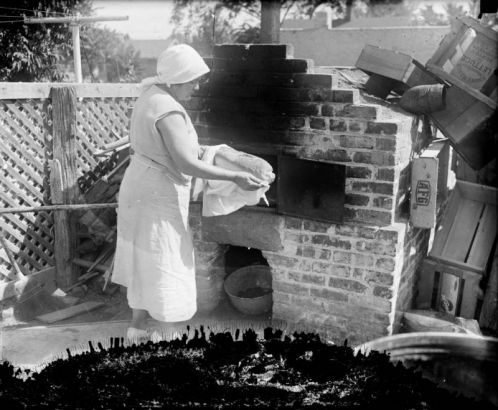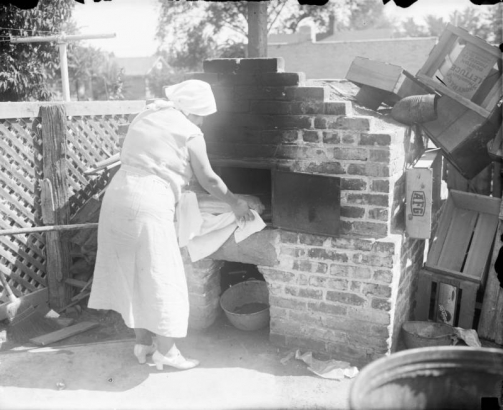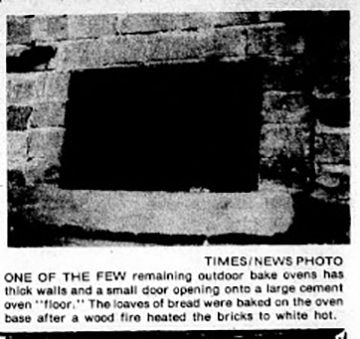North Denver's backyards were once more suited to bread than barbecue.
The Northside (an area of Denver that includes the neighborhoods of Highlands, Sunnyside, and Jefferson Park) was once home to a vibrant community of Italian Americans. In the interest of feeding one's family inexpensively—while keeping traditions of Italian bread making alive—some Northsiders baked bread in brick backyard ovens.
Italian immigrants were drawn to an area centered on Navajo, Osage, and Pecos Streets....The air was filled with the scent of bread baking in outdoor dome ovens.
–Northwest Denver by Mark A. Barnhouse (Arcadia Publishing: 2012)
Although a handful of books housed in the Western History and Genealogy department (WHG) reference these ovens, few photographs in the collection do. Fortunately, History Colorado has collected photographs of the outdoor ovens, acquired through its Italian American community documentation project, which launched in 2002. The project resulted in the largest Italian American research archive in the West, as well as History Colorado's publication of Italy in Colorado: Family Histories from Denver and Beyond by Alisa DiGiacomo in 2008.
That same History Colorado documentation project yielded several oral history interviews with Denver's Italian Americans. In a 2004 interview, Fred Sabell described his mother's outdoor oven in Sunnyside:
"...she had an oven outside—an outside oven and it was huge! It was almost as big as my living room and she would put dough in there and make bread and even had one of those things you push to get like ten loaves of bread in there, so she'd sell bread to the neighbors. ...I think the bread was a quarter."
It wasn't uncommon for women to sell their extra bread. A typical oven—constructed of brick with a rounded, beehive-like roof covered in cement or stucco—was usually large enough to bake between ten and twelve loaves at a time.
Louisville resident Lena (Polluconi) Ingram had a 16-loaf forno (Italian for "oven"), which she used to bake bread for the Colacci grocery store. It was a way to support her family after her husband, Martin Polluconi, was killed in a Matchless Mine accident in 1929.
Mrs. Ingram’s recipe began with 50 pounds of flour (she used Hungarian flour), the salt added to the flour, potato water made from boiled potatoes that were strained, and yeast foam which she "started” the night before. The ingredients were mixed together, the 16 large loaves where shaped, sometimes into rounds and sometimes long loaves, the fire fed until the bricks were white hot, and the oven cleaned with a broom which had been made of corn shucks. The loaves baked in about 35 to 40 minutes, and were judged baked when they had reached the proper shade of brown.
–"Outdoor Ovens Here Abandoned: Progress Ends Old World Baking Tradition" by Carolyn Connaroe, Louisville Times, May 12, 1977
Towards the latter part of the 20th century, the outdoor ovens fell out of favor as people moved, supermarkets proliferated, and cultures changed. Given the ovens' backyard locations, it is hard to know how many ovens—if any—survive today in North Denver.
Just which homes had outdoor ovens? Unfortunately, this information was not recorded on Sanborn Fire Insurance maps, which—as the Library of Congress puts it—"show the size, shape and construction materials of dwellings, commercial buildings, factories and other structures."
For now, photographs, newspaper articles, and oral history interviews provide the most information about the history of this phenomenon.
Do you have a bread oven in your yard? Or, do you remember seeing outdoor ovens in Denver? We'd love to hear from you! Please comment below.





Comments
It would be great if we could
It would be great if we could find a plan for how to build a replica of a North Denver bread oven.
I concur, Clara! I haven't
I concur, Clara! I haven't tracked one down...yet.
Take a look at Carbondale
Take a look at Carbondale Community Oven Facebook page, or website: carbondalecommnityoven.weebly.com
My grandfather, and two
My grandfather, and two daughters who survived him in the same house on Pecos had a brick oven in the back yard until it was demolished to make room for a garage in the 1970s. I never witnessed any bread baking, but heard about it from my mother and aunts. I'll have to look through our old photos.
Wonderful, John! Hoping you
Wonderful, John! Hoping you can find a photograph! Thanks for reading and commenting.
Well the focus has been on
Well the focus has been on Italian roots of backyard oven this also has a place in Hispano communities. One still sees hornos in the San Luis Valley particularly in the area south east of San Luis. I have seen historic postcards showing a typical beehive shaped hornos. You would think that migrants from the Valley would have this a family r
.. Would have brought the
.. Would have brought the ovens and traditional family recipes north to Denver.
Thanks for bringing up the
Thanks for bringing up the hornos of the San Luis Valley, Tom! This is a topic I hope to cover in a future post of its own.
Around 1950, my father built
Around 1950, my father built a fireplace with two levels. And a cook top above. Every Sunday afternoon during the summers of my childhood, my mother cooked our Sunday dinner there. Potatoes, fried chicken and beans or peas. She did use it also to let her homemade bread rise when the cook top was still warm. We ate those dinners in our grape arbor which always gave us bushels of concord grapes every year. We lived at 3416 Meade St.
What a delicious feast,
What a delicious feast, Darlene! Thank you so much for sharing your good memories with us.
Add new comment